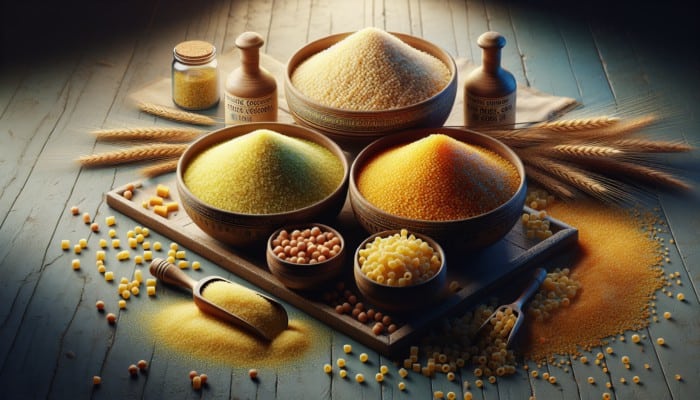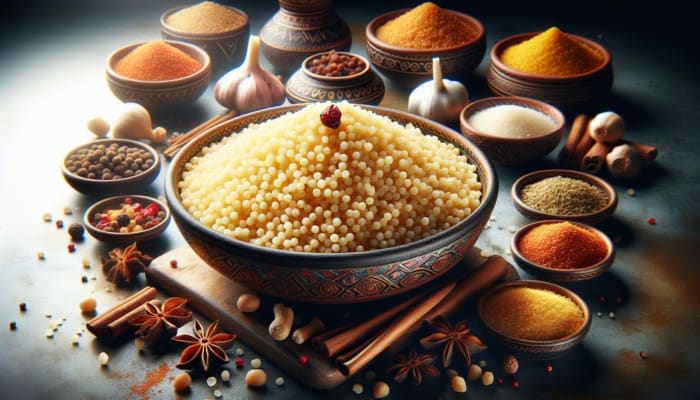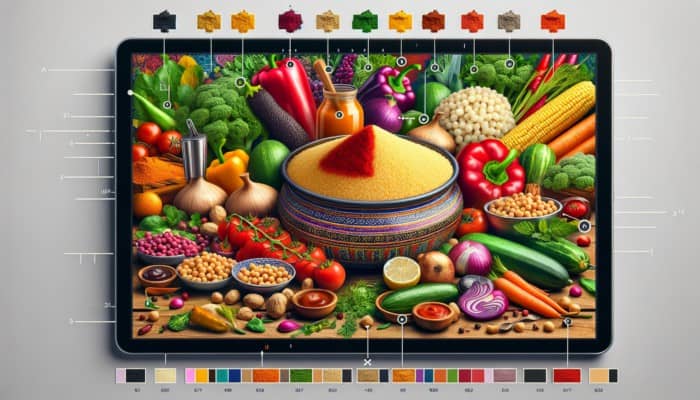Master the Art of Creating a Delicious Tunisian Couscous: Essential Ingredients You Need
Starting with the right ingredients is crucial to crafting a genuinely delicious Tunisian couscous. The quality and freshness of each component will significantly impact the final flavor of your dish. This section will delve into the key ingredients that will give your couscous its authentic and irresistible taste.
Selecting and Preparing the Best Couscous for Flavorful Results

Choosing the correct type of couscous is fundamental to achieving a mouthwatering, delicious Tunisian couscous. Traditionally, couscous is made from semolina derived from durum wheat, providing a light and fluffy texture. You can opt for fine, medium, or coarse couscous, each offering a distinct culinary experience. Fine couscous is perfect for side dishes, while medium is often preferred for main courses.
To prepare the couscous, start by rinsing it under cold water to remove excess starch. This step is crucial in preventing clumping. After rinsing, place the couscous in a large bowl and add enough hot water to moisten it. Allow it to rest for 30 minutes, then fluff it with a fork to achieve the perfect texture.
Enhance Your Dish with the Perfect Spices: Cumin, Coriander, and Paprika
Spices are the very heart of a delicious Tunisian couscous. The combination of cumin, coriander, and paprika adds a unique depth of flavor. Cumin brings an earthy aroma, while coriander adds citrusy notes that complement each other beautifully. Meanwhile, paprika lends a hint of sweetness and a vibrant red color to the dish.
To maximize the effectiveness of these spices, lightly toast them in a dry pan before adding them to your couscous. This process enhances their aromatic qualities and releases essential oils. Once toasted, mix them directly into your couscous for a burst of flavor that elevates the entire dish.
Incorporating Nutritious Vegetables: Carrots, Zucchini, and Chickpeas
Vegetables play a vital role in the composition of a delicious Tunisian couscous. Carrots, zucchini, and chickpeas bring varied textures and provide nutritional richness. Diced or sliced carrots add natural sweetness, while zucchini contributes lightness and freshness to the dish.
Rich in protein, chickpeas are often considered a staple in couscous. They should be cooked until tender and then integrated with the other vegetables. For optimal results, sauté your vegetables in olive oil before adding them to the couscous to enhance their flavors. By combining these ingredients, you'll create a balanced and flavorful dish that will delight the palates of all your guests.
Master the Art of Cooking a Delicious Tunisian Couscous: Techniques You Need to Know

Cooking plays a crucial role in creating a delicious Tunisian couscous. Whether you choose the traditional method using a couscoussier or a more modern approach, each technique has advantages. This section will explore the various cooking methods for couscous and tips to achieve the perfect texture.
Traditional Cooking Method: How to Use a Couscoussier
The traditional method of cooking couscous involves using a couscoussier, a two-tiered utensil that allows for steaming. This technique maintains authenticity and ensures that the couscous absorbs all the flavors from the broth. Begin by filling the bottom part of the couscoussier with water and bring it to a boil. Next, place the semolina in the top section.
It is essential to keep the couscous well-aerated. To achieve this, gently stir it every 10 minutes and mist it with water to keep it moist. While this method may take some time, the result is worth the effort. A traditionally cooked couscous will be light, fluffy, and flavorful.
Modern Cooking Method: Steaming for Efficiency
Steaming is an excellent alternative for those who prefer a quicker approach. This method utilizes a steam pot or steamer, allowing the couscous to cook while preserving its nutrients. Add water to the bottom of the pot and place the couscous in the steaming basket. Cooking for 15 to 20 minutes is usually sufficient for a perfect result.
Although this method is faster, it requires careful attention to prevent the couscous from becoming sticky. Adding a small amount of olive oil to the couscous before cooking can help separate the grains. This method can quickly achieve delightfully fluffy couscous.
Tips for Achieving the Perfect Couscous Texture

Achieving the perfect texture for your delicious Tunisian couscous requires key tips. One of the most important things is to avoid over-moistening the couscous during preparation. Excess moisture can lead to a gummy consistency. Instead, gradually sprinkle water over it and allow it to rest, enabling the grains to swell properly.
Another secret lies in using broth instead of water to hydrate the couscous. This will enrich the flavor and add an extra dimension to your dish. Finally, remember to fluff the couscous after cooking. This ensures the grains remain separate and airy, ready to absorb all the delightful flavors you plan to add.
Unlock the Secrets to Flavor in a Delicious Tunisian Couscous
The flavors of a delicious Tunisian couscous extend beyond just the basic ingredients. The secrets to a truly exceptional dish lie in the details, particularly the broth, spice blend, and fresh herbs. This section will explore these elements to elevate your couscous to the next level.
The Importance of Broth: Meat or Vegetables?
The broth is the key element that binds all the ingredients of a delicious Tunisian couscous. Whether you choose a meat or vegetable broth, it should be rich and aromatic. For a traditional couscous, meat broth, typically made from Lamb or chicken, is favored. The meat should be simmered with onions, garlic, and spices to extract all the flavors.
If you prefer a vegetarian version, a well-seasoned vegetable broth can work just as well. Use vegetables like carrots, leeks, and celery to create a flavorful broth. The key is to let the broth simmer long enough for all the flavors to meld and intensify.
The Art of Blending Spices for Maximum Flavor
The spice blend sets a delicious Tunisian couscous apart from other dishes. The art of mixing spices lies in achieving balance. You can experiment with spices such as ras el hanout, a traditional Moroccan blend that adds depth of flavor. Add it gradually and taste as you go to find the perfect balance.
Feel free to customize the blend according to your personal preferences. For instance, you might introduce a hint of cinnamon for sweetness or cardamom for an exotic touch. The goal is to create a harmonious flavor profile that enhances every bite of your couscous.
The Role of Fresh Herbs: Parsley and Coriander
Fresh herbs like parsley and coriander are essential in finishing a delicious Tunisian couscous. They bring freshness and brightness that balance the dish's rich flavors. Add the herbs just before serving to preserve their aroma and vibrant color for the best taste.
You can also use them as a garnish for your couscous. A simple handful of chopped coriander or parsley can transform the appearance of your dish, making it more appetizing. Beyond aesthetics, these herbs also provide nutritional benefits, adding vitamins and antioxidants to your meal.
Explore Regional Variations of Delicious Tunisian Couscous
The delicious Tunisian couscous is not a monolithic dish; numerous regional variations reflect Tunisia's cultural diversity. Each region has its interpretations and ingredients, making each version unique. In this section, we will explore some of these variations.
Couscous from Sfax: Featuring Seafood
Sfax-style couscous is a coastal specialty distinguished by the use of seafood. This variation is often prepared with shrimp, mussels, and fish, offering an unparalleled culinary experience. The seafood is cooked in a savory broth that enhances the flavors of the couscous.
To prepare this couscous, cook the seafood separately with spices and garlic. Then, incorporate it into the couscous just before serving. This method ensures that the seafood remains tender and juicy. The result is a dish beautifully marries land and sea, perfect for seafood lovers.
Couscous from Djerba: Infused with Harissa
The Djerba variant is characterized by the generous use of harissa, a spicy chili paste that brings heat and depth. Harissa is often mixed directly into the couscous or served on the side, allowing each person to adjust the heat level to their liking.
To create a Djerba-style couscous, traditionally prepare the couscous and mix harissa into the broth. This imparts a beautiful red hue to the dish while enhancing the flavors. Spice enthusiasts will undoubtedly appreciate this bold and fiery dish.
Couscous from the South: Berber Influence
Southern-style couscous, influenced by Berber culture, is often prepared with local ingredients such as dates, almonds, and various spices. Its sweet-salty flavour distinguishes this version, offering a unique culinary experience. Dates, in particular, add a natural sweetness that harmonizes beautifully with the savory elements of the dish.
To prepare a Southern-style couscous, incorporate dried fruits and nuts into the vegetable mix. This creates a delightful contrast of textures and flavors, intriguing every bite. This variation is often served during celebrations and gatherings, adding a festive touch to any meal.
Elevate Your Delicious Tunisian Couscous with Perfect Accompaniments and Garnishes
Accompaniments and garnishes are crucial in enhancing the presentation and flavor of your delicious Tunisian couscous. While it can stand alone as a main dish, it is often served with various sides that enrich the culinary experience. Let's explore the best options together.
Meats: Merguez and Lamb
Meat is a central element in many recipes for delicious Tunisian couscous. Merguez, spicy sausages made from Lamb, are a popular choice. They add intense flavor and a slight kick that perfectly complements the couscous.
To prepare them, grill or pan-fry them until golden brown. Add them to the couscous just before serving. On the other hand, Lamb is often slow-cooked with spices and vegetables, yielding tender meat that melts in your mouth. Serving these meats as sides transforms your couscous into a hearty and flavorful meal.
Roasted Vegetables: Eggplants and Peppers
Roasted vegetables add a touch of sweetness and depth to the delicious Tunisian couscous. Eggplants and peppers are particularly excellent choices. They can be roasted in the oven with olive oil and spices until beautifully caramelized.
To prepare this garnish, chop the vegetables into chunks and season them with salt, pepper, and herbs. Roast them at a high temperature to bring out their natural flavors. Serving these on top of the couscous adds vibrant colours and introduces varied textures that enhance the overall dish.
Flavorful Sauces: Harissa and Labneh
Sauces are essential for elevating the taste of your delicious Tunisian couscous. Harissa, in particular, is a must-have. This spicy chili paste can be served on the side for those who enjoy a bit of heat. Its richness and spiciness add an extra dimension to every bite.
Labneh, a creamy strained yogurt, is another excellent option. Its smooth texture and slightly tangy flavor beautifully balance the spices in the couscous. Serving a dollop of labneh atop your dish offers a refreshing touch that complements the intense flavors of the couscous.
Essential Tips for Beginners: Crafting a Delicious Tunisian Couscous
If you are new to preparing delicious Tunisian couscous, don't worry. You can create a delightful and impressive dish with a few practical tips. In this section, we will share some advice to help you make your couscous easily.
Ingredient Planning for Success
Planning is vital for successfully preparing your delicious Tunisian couscous. Before you begin, ensure that you have all the necessary ingredients at your fingertips. This includes couscous and vegetables, spices, and meat or vegetarian alternatives.
Make a shopping list and try to choose fresh, high-quality ingredients. Additionally, prepare your vegetables in advance by chopping and storing them in the refrigerator. This will save you time during preparation and allow you to focus on cooking.
Cooking Timing for Perfect Results
Timing is critical when preparing a delicious Tunisian couscous. Be sure to adhere to the cooking times for each component. For instance, cooking meat or broth will take longer. Meanwhile, you can prepare the couscous and vegetables.
Generally, couscous cooks faster than the other elements. Therefore, consider preparing it last to ensure it is hot and fluffy when serving. Proper time management will allow you to present your guests with a hot and flavorful dish.
Presentation and Serving Tips
Presentation is key for a dish as appetizing as delicious Tunisian couscous. Use a large serving platter to showcase your couscous. Arrange the vegetables and meats on top, creating an attractive visual display. Don't hesitate to add a sprinkle of coriander or parsley for a pop of color.
Also, ensure that sauces such as harissa and labneh are served on the side, allowing everyone to customize their dish. A beautiful presentation not only pleases the eye but also enhances the overall dining experience.
Frequently Asked Questions About Delicious Tunisian Couscous
Can You Prepare Couscous in Advance?
Yes, you can prepare couscous in advance. It is best stored in an airtight container in the refrigerator. Reheat it gently before serving to restore its fluffy texture.
How Should You Store Leftover Couscous?
Leftover couscous keeps well in the refrigerator in an airtight container. It can be consumed within 3 to 4 days. To prevent it from drying out, add some water to reheat it.
Is It Possible to Make a Vegan Couscous?
Absolutely! You can prepare a completely vegan couscous using vegetable broth and assorted vegetables. Add chickpeas for a protein boost.
What Types of Meat Can Be Used?
Traditionally, Lamb and chicken are used, but you can also opt for beef or merguez sausages for additional flavor.
Which Type of Couscous Is Best?
Due to its ideal texture, medium couscous is often recommended for main dishes, while fine couscous works best for side dishes.
Can You Use Pre-Made Spice Mixes?
Yes, pre-made spice blends can be convenient. Just ensure that you select high-quality blends for an authentic taste.
Can Couscous Be Served Cold?
Yes, couscous can be served cold, especially in salads. Add fresh vegetables and a dressing for a refreshing summer dish.
How Can You Prevent Couscous from Sticking?
To prevent couscous from sticking, add a bit of olive oil during preparation and fluff it after cooking.
Can I Make Couscous in a Pressure Cooker?
Yes, a pressure cooker can be used to cook couscous quickly. Follow your appliance's instructions for optimal results.
Is Couscous a Healthy Dish?
Yes, couscous is a healthy option, especially with fresh vegetables and lean proteins. It is a dish rich in nutrients and flavors.



It’s fascinating how the choice and preparation of ingredients can transform a dish into something extraordinary. I completely agree that starting with high-quality couscous is essential. I’ve experimented with different types, and I’ve found that coarse couscous truly absorbs flavors beautifully, especially when paired with a rich sauce or a stew.
I completely resonate with that perspective. The right ingredients really do have the power to elevate a dish. Coarse couscous is a great choice, especially how it can act like a canvas for flavors. I’ve also found that letting it rest for a bit after cooking allows it to absorb even more of the surrounding sauce, which can be a game changer.
I totally get what you’re saying about coarse couscous being like a flavor canvas. It really is one of those ingredients that you can dress up or down depending on what you’re going for. I love how its texture can soak up different sauces, making each bite a little different.
You make a great point about coarse couscous serving as a fantastic canvas for flavors. One of the things I love about it is its versatility; it really does soak up the nuances of whatever sauces or dressings you pair it with. Your tip about letting it rest after cooking is spot on too. It’s such a simple step but can transform the final dish by allowing the couscous to absorb more moisture and flavor.
“I’m glad you feel that way! If you’re interested in exploring more tips and recipes that highlight the versatility of couscous and other ingredients, check out this guide I put together.”
https://cookinggods.com/DigestiveHealth
I’m really glad you resonate with the versatility of couscous. It’s fascinating how a simple grain can transform based on the ingredients and techniques we use. I’ve found that adding a hint of citrus or herbs can really elevate the flavor, making it feel fresh and vibrant. It reminds me of how many dishes from different cultures apply a similar principle—like rice dishes that are enhanced with spices or sauces.
I’m glad you feel that way about ingredients! Coarse couscous has a unique ability to soak up all those rich flavors, which can elevate a dish in surprising ways. Have you tried pairing it with different spices or herbs? It’s always interesting to see how the flavor profile shifts. I’ve found that adding a hint of lemon zest or a sprinkle of fresh herbs can really enhance the experience. It’s all about finding that perfect balance, isn’t it? What’s been your favorite stew to pair with it?
Absolutely! If you’re interested in exploring more about the different types of couscous and how to elevate your dishes even further, check out this link for some inspiring recipes and tips!
https://cookinggods.com/ChocolateHealth
I really enjoyed your insights on the importance of quality ingredients for Tunisian couscous! It’s fascinating how something as simple as choosing the right couscous can elevate a dish. I remember the first time I tried making couscous at home; I went with the fine variety, thinking it’d be an easy go-to. While it turned out tasty, I quickly learned that medium couscous has a lovely bite that just adds to the overall experience.
I’m glad you found the insights helpful! It’s fascinating how a seemingly small detail like the type of couscous can really change the dynamic of a dish. Medium couscous does bring that nice texture and heartiness that makes each bite more satisfying. It can be surprising how much more enjoyable cooking can be when you dig a little deeper into the ingredients.
I’m glad you enjoyed the article! If you’re looking to elevate your couscous dishes even further, check out this curated selection of high-quality Tunisian couscous options. Happy cooking!
https://cookinggods.com/ChocolateHealth
Your blog post on Tunisian couscous highlights a culinary tradition that is not only delicious but also rich in cultural significance. The emphasis on selecting quality ingredients resonates deeply, as the flavors in Tunisian cuisine are often a reflection of the fresh produce and spices that characterize the region.